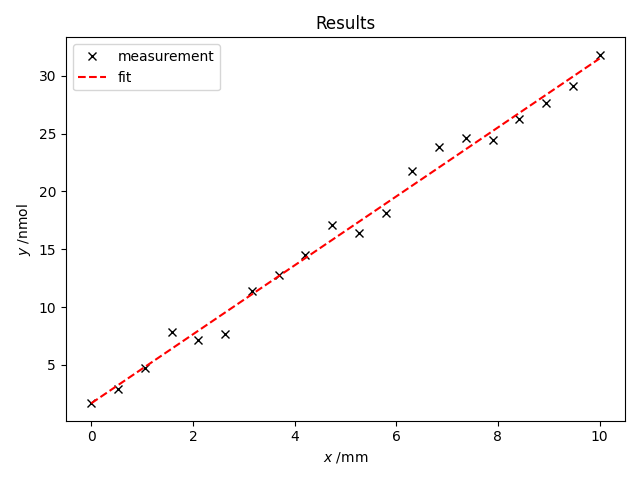Example Applications¶
Read a raw measurement file, fit a curve, save and plot the results¶
>>> import matplotlib.pyplot as plt
>>> import numpy as np
>>> from SDF.data_model import Workspace, ArrayDataset1D
>>> from SDF.file_io import write_sdf, load_from_sdf
>>> # 0. create some data (usually read from measurement file)
>>> n_points = 20
>>> a, b = 3, 1.5
>>> x = np.linspace(0, 10, n_points)
>>> y = a*x + b + np.random.normal(size=n_points)
>>> ws = Workspace(name="top-level workspace", owner="Albertus")
>>> ws.datasets.add(ArrayDataset1D(name="x", data=x, unit="mm"))
>>> ws.datasets.add(ArrayDataset1D(name="y", data=y, unit="nmol"))
>>> ws.instruments["Supermeter 2000"] = {"nickname": "Sir cannot-fail",
... "settings": {"good day": True, "mood": 10}}
>>> write_sdf(ws, "my-results.sdf")
>>> # 1. read data, fit curve
>>> ws = load_from_sdf("my-results.sdf")
>>> fit_a, fit_b = np.polyfit(x, y, deg=1)
>>> # 2. add fit results to workspace
>>> ws.parameters["fit results"] = {"a": (fit_a, "nmol"),
... "b": (fit_b, "nmol/mm"),
... "method": {"name": "np.polyfit", "degree": 1}}
>>> write_sdf(ws, "my-results.sdf")
>>> # 3. plot
>>> x = ws.datasets["x"].data
>>> x_unit = ws.datasets["x"].unit
>>> y = ws.datasets["y"].data
>>> y_unit = ws.datasets["y"].unit
>>> fit_a = float(ws.parameters["fit results"]["a"].value)
>>> fit_b = float(ws.parameters["fit results"]["b"].value)
>>> def plot(x, y, y_fit, x_unit, y_unit):
... plt.plot(x, y, "xk", label="measurement")
... plt.plot(x, y_fit, "--r", label="fit")
... plt.xlabel(f"$x$ /{x_unit}")
... plt.ylabel(f"$y$ /{y_unit}")
... plt.legend()
... plt.title("Results")
... plt.tight_layout()
>>> plot(x, y, fit_a*x + fit_b, x_unit, y_unit)
>>> plt.savefig("my-results.png")
The resulting file my-results.sdf will look like this:
<?xml version="1.0" encoding="utf-8"?>
<!DOCTYPE workspace>
<workspace>
<name>
top-level workspace
</name>
<owner>
Albertus
</owner>
<par name="fit results">
<par name="a" value="2.9781712899700308" unit="nmol"/>
<par name="b" value="1.5456773747402146" unit="nmol/mm"/>
<par name="method">
<par name="degree" value="1"/>
<par name="name" value="np.polyfit"/>
</par>
</par>
<instrument>
<name>
Supermeter 2000
</name>
<par name="nickname" value="Sir cannot-fail"/>
<par name="settings">
<par name="good day" value="True"/>
<par name="mood" value="10"/>
</par>
</instrument>
<dataset type="sc">
<name>
x
</name>
<unit value="mm"/>
<data rows="20" cols="1" type="float">
0.0 0.5263157894736842 1.0526315789473684 1.5789473684210527 2.1052631578947367 2.631578947368421
3.1578947368421053 3.6842105263157894 4.2105263157894735 4.7368421052631575 5.263157894736842 5.789473684210526
6.315789473684211 6.842105263157895 7.368421052631579 7.894736842105263 8.421052631578947 8.947368421052632
9.473684210526315 10.0
</data>
</dataset>
<dataset type="sc">
<name>
y
</name>
<unit value="nmol"/>
<data rows="20" cols="1" type="float">
1.0194935272080436 3.313324719409985 4.016299212544986 7.627843194351737 6.31005069389586 10.487992770591923
11.123057149457448 11.80545784430888 14.494353262577148 14.824419224980307 18.545437261147292 18.63781216938566
20.146171321403752 22.963561113724747 23.964314703838614 25.80381228448588 24.440242187106243
27.620432980775806 29.404287266310554 32.18231360430237
</data>
</dataset>
</workspace>
The plot will look like this:

Fig. 19 my-results.png¶
Generate a nested Workspace with multiple Datasets¶
>>> from datetime import datetime
>>> from PIL import Image
>>> import numpy as np
>>> from SDF.data_model import Workspace, ImageDataset, ArrayDataset1D
>>> from SDF.file_io import write_sdf
>>> sdf = Workspace(name="my experiment", owner="me", date=datetime.now())
>>> sdf.comment = "comment on the experiment"
>>> sdf.samples["my first sample"] = "sample description"
>>> sdf.samples["my second sample"] = "sample description"
>>> measurement_1 = Workspace("my first measurement")
>>> sdf.workspaces.add(measurement_1)
>>> measurement_1.comment = "comment on my first measurement:\n" \
... " - it consists of two images\n" \
... " - they are random, but beautiful!"
>>> measurement_1.instruments["my microscope"] = dict(cost=(9001, "EUR"), color="black")
>>> image_1 = Image.fromarray(np.random.randint(0, 255, (10, 10), dtype=np.uint8)) # random 10x10 image
>>> image_2 = Image.fromarray(np.random.randint(0, 255, (10, 10), dtype=np.uint8))
>>> measurement_1.datasets.add(ImageDataset("image 1", image_1))
>>> measurement_1.datasets["image 1"].parameters["zoom-level"] = 30
>>> measurement_1.datasets["image 1"].parameters["wavelength"] = 509, "nm"
>>> measurement_1.datasets.add(ImageDataset("image 2", image_2))
>>> measurement_2 = Workspace("my second measurement")
>>> sdf.workspaces.add(measurement_2)
>>> measurement_2.comment = "comment on my first measurement"
>>> x = np.arange(100)
>>> y = np.random.randint(0, 10, 100)
>>> measurement_2.datasets.add(ArrayDataset1D("x", x))
>>> measurement_2.datasets.add(ArrayDataset1D("y", y))
>>> write_sdf(sdf, "my-results.sdf")
The resulting file my-results.sdf would look like this:
<?xml version="1.0" encoding="utf-8"?>
<!DOCTYPE workspace>
<workspace>
<name>
my experiment
</name>
<owner>
me
</owner>
<date>
2021.03.03 11:01:28
</date>
<comment>
comment on the experiment
</comment>
<sample>
<name>
my first sample
</name>
<comment>
sample description
</comment>
</sample>
<sample>
<name>
my second sample
</name>
<comment>
sample description
</comment>
</sample>
<workspace>
<name>
my first measurement
</name>
<comment>
comment on my first measurement:
- it consists of two images
- they are random, but beautiful!
</comment>
<instrument>
<name>
my microscope
</name>
<par name="color" value="black"/>
<par name="cost" value="9001" unit="EUR"/>
</instrument>
<dataset type="img">
<name>
image 1
</name>
<par name="zoom-level" value="30"/>
<par name="wavelength" value="509" unit="nm"/>
<data encoding="base64" type="image/png">
iVBORw0KGgoAAAANSUhEUgAAAAoAAAAKCAAAAACoWZBhAAAAeUlEQVR4nAFuAJH/AZAWa0VE4fDv
DEMAWrhy8Ap+NRE0VwIP2W6xVnz36/tkBECg6Br6DZSfxtwArc1sCMhI+QTlQASDQCtSFPwonKkl
ABlDAnNLCJI3owsBn1+a/M2JOlv88QBxoT/oB/x8FtApAak8PoLosFYFybBPszA9DBBXFAAAAABJ
RU5ErkJggg==
</data>
</dataset>
<dataset type="img">
<name>
image 2
</name>
<data encoding="base64" type="image/png">
iVBORw0KGgoAAAANSUhEUgAAAAoAAAAKCAAAAACoWZBhAAAAeUlEQVR4nAFuAJH/AV2nPj/syu3s
q1EAGGJHzgLvp7gliQJd+s1UeOgI0TtGALgZ+RDJLsZBD6cC0WE59UEZBdHxFwAhlFXietBCH3tj
AFEbsOITtH4B3qcAzD/+lO8Iz5QyfAGIISIjCDwTyvp2AFHbtb0Fkcn8INWzmDFI/vtkfAAAAABJ
RU5ErkJggg==
</data>
</dataset>
</workspace>
<workspace>
<name>
my second measurement
</name>
<comment>
comment on my first measurement
</comment>
<dataset type="sc">
<name>
x
</name>
<data rows="100" cols="1" type="int">
0 1 2 3 4 5 6 7 8 9 10 11 12 13 14 15 16 17 18 19 20 21 22 23 24 25 26 27 28 29 30 31 32 33 34 35 36 37 38
39 40 41 42 43 44 45 46 47 48 49 50 51 52 53 54 55 56 57 58 59 60 61 62 63 64 65 66 67 68 69 70 71 72 73 74
75 76 77 78 79 80 81 82 83 84 85 86 87 88 89 90 91 92 93 94 95 96 97 98 99
</data>
</dataset>
<dataset type="sc">
<name>
y
</name>
<data rows="100" cols="1" type="int">
0 1 4 6 7 3 4 0 8 5 9 7 7 6 2 8 1 4 9 5 8 9 5 6 8 4 5 8 1 9 8 9 1 5 1 3 7 2 0 9 0 2 0 6 6 2 0 3 6 4 0 1 2 2
5 6 4 6 9 9 2 0 6 3 4 1 6 2 8 7 7 6 5 5 6 4 0 6 7 5 8 7 8 4 2 0 3 0 4 5 2 7 5 7 4 5 8 2 2 0
</data>
</dataset>
</workspace>
</workspace>